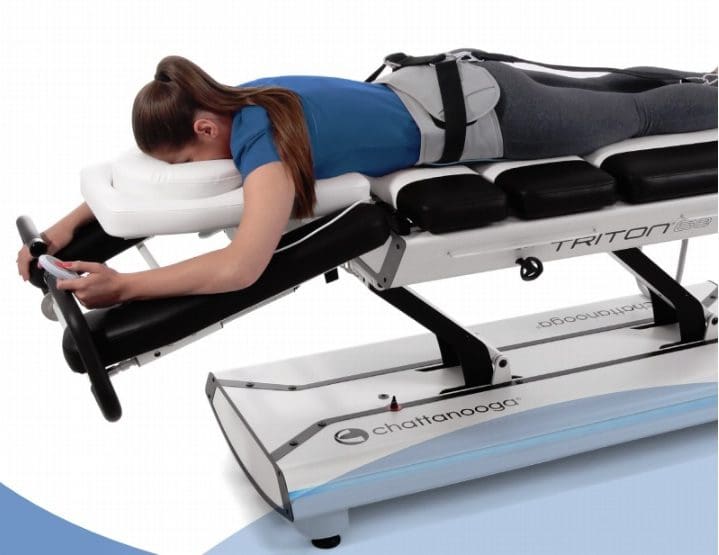Contents
Introduction
The spine’s primary function is to make sure that the body is moving, twisting, turning, and bending at any angle without any pain. When the spine gets injured in an accident or a back muscle is pulled, it can cause the spinal discs in the spine to become herniated or develop degenerative disorders like DDD (degenerative disc disease) that can cause a person to be in pain. Other back pain issues that can cause a person to be in pain include sciatica, chronic back pain, leg pain, and the inability to move or stand for long periods. When many individuals suffer from back pain, it can cause them to lose their quality of life and make them feel miserable. Luckily there are ways to treat back pain, and that is through non-surgical decompression therapy. In this article, we will be looking at facet syndrome and its symptoms and how decompression can alleviate pain associated facet syndrome. By referring patients to qualified and skilled providers specializing in spinal decompression therapy. To that end, and when appropriate, we advise our patients to refer to our associated medical providers based on their examination. We find that education is the key to asking valuable questions to our providers. Dr. Alex Jimenez DC provides this information as an educational service only. Disclaimer
Can my insurance cover it? Yes, it may. If you are uncertain, here is the link to all the insurance providers we cover. If you have any questions, please call Dr. Jimenez at 915-850-0900.
What Is Facet Syndrome?
As previous articles mentioned, many individuals have back pain is common worldwide and is one of the most expensive conditions to be treated for. This is due to many individuals straining their back by lifting heavy objects, or their spinal disc is deteriorating due to aging naturally. When the spinal disc starts to lose its function naturally, the outer barrier of the spinal disc begins to become hard. It becomes compressed, losing its soft sponge-like texture, causing the inner walls of the spinal disc to push through the compressed outer layers and become herniated. Facet syndrome is another back pain issue that many individuals tend to suffer due to natural aging. Research studies have stated that facet syndrome is a condition where the spine’s joints start to degenerate and become a source of pain. Facet syndrome can be caused when the joints from the spine begin to get inflamed and degenerate, causing many other back pain disorders to rise like spondylosis, osteoarthritis, and rheumatoid arthritis all over the body.
Other research studies have shown that facet syndrome is the source of chronic spinal pain that can be unilateral or bilateral back pain radiating from one or both buttocks, the sides of the groin, and the thighs, and just stopping at the knees. Facet syndrome can also mimic any excruciating pain that is caused by herniated discs or compressed nerve roots on the spine.
Facet Syndrome Symptoms
Since facet syndrome is the most common cause of low back pain, research studies have shown that local aches often characterize facet syndrome to some degree of stiffness on the spinal joints. The pain from facet syndrome usually ranges from a dull ache to sharp shooting pain that causes the person to be unable to function. Some of the signs and symptoms caused by facet syndrome are similar to other back pains. They occur together and cause overlap, making the diagnosis challenging for health practitioners. The signs and symptoms of facet syndrome usually depend on the severity and involvement of a nearby nerve root which can cause:
- Low back pain
- Facet arthritis
- Sciatica
- Tenderness on palpation
- Causing painful effects on posture and activity
- Stiffness
- Crepitus
Decompression Therapy Effectiveness For Facet Syndrome-Video
The video above shows how the DRX9000 decompression machine treats facet syndrome. Research studies have shown that facet syndrome is caused by degeneration of the spinal joints due to repetitive overuse and everyday activities that cause microinstability and compress the surrounding nerve roots. When this happens, it can cause excruciating back pain to the individual. With the DRX9000 decompression machine, many individuals will begin to feel relief from facet syndrome. As part of spinal decompression therapy, the DRX9000 decompression machine gently stretches the spine to release the compressed spinal discs and allow the beneficial nutrients and oxygen back into the spine. Many individuals with low back pain begin to feel relief by utilizing decompression therapy as part of their wellness journey. If you want to learn more about spinal decompression therapy, this link will explain the benefits of spinal decompression and how it can alleviate low back pain symptoms.
Decompression Therapy For Facet Syndrome
Decompression therapy is utilized for individuals suffering from low back pain and facet syndrome. As research studies have shown, the effectiveness of decompression therapy can help individuals with facet syndrome by improving their mobility and activities of daily living and reducing their pain after treatment. Decompression therapy can also help individuals reposition the herniated discs back into the spine and can cause the spinal joints to increase in height. Other research studies have shown that since facet syndrome is the cause of low back pain, radiculopathy, and neurological deficits due to being close to the adjacent nerve root, decompression therapy can gently stretch the compressed nerve root and cause instant relief to the individual. When individuals combine decompression therapy with physical therapy, it will reduce the chances of painful symptoms coming back.
Conclusion
Therefore, facet syndrome is one of the common causes of low back pain that causes degeneration of the spinal joints. Facet syndrome is also one of the sources of pain and can mimic other painful back symptoms that can overlap, affect the nearest nerve root, and be hard to diagnose. All is not lost as decompression therapy is used as a non-surgical option to relieve back pain issues by gently stretching the spinal disc, joints, and ligaments to relieve the pressure it was under. Decompression therapy has helped reduce many chronic back issues that many individuals have suffered by allowing the nutrients to go back to the spine. With the combination of physical therapy, many individuals who utilize decompression therapy as part of their wellness journey will become pain-free over time.
References
Alexander, Christopher E, et al. “Lumbosacral Facet Syndrome – Statpearls – NCBI Bookshelf.” StatPearls [Internet]. Treasure Island (FL), StatPearls Publishing, 12 Feb. 2022, https://www.ncbi.nlm.nih.gov/books/NBK441906/.
Curtis, Lindsay, et al. “Facet Joint Disease – Statpearls – NCBI Bookshelf.” StatPearls [Internet]. Treasure Island (FL), StatPearls Publishing, 15 Jan. 2022, https://www.ncbi.nlm.nih.gov/books/NBK541049/.
Gose, E E, et al. “Vertebral Axial Decompression Therapy for Pain Associated with Herniated or Degenerated Discs or Facet Syndrome: An Outcome Study.” Neurological Research, U.S. National Library of Medicine, Apr. 1998, https://pubmed.ncbi.nlm.nih.gov/9583577/.
Parker, Larry. “Symptoms and Diagnosis of Facet Joint Disorders.” Spine, Spine-Health, 24 June 2020, https://www.spine-health.com/conditions/arthritis/symptoms-and-diagnosis-facet-joint-disorders.
Perolat, Romain, et al. “Facet Joint Syndrome: From Diagnosis to Interventional Management.” Insights into Imaging, Springer Berlin Heidelberg, Oct. 2018, https://www.ncbi.nlm.nih.gov/pmc/articles/PMC6206372/.
Sagoo, Navraj S, et al. “Lumbar Facet Joint Cyst Treated with Decompression and Interlaminar Stabilization.” Cureus, Cureus, 25 July 2020, https://www.ncbi.nlm.nih.gov/pmc/articles/PMC7445097/.
Disclaimer
General Disclaimer, Licenses and Board Certifications *
Professional Scope of Practice *
The information herein on "Decompression Therapy For Pain Associated Facet Syndrome" is not intended to replace a one-on-one relationship with a qualified health care professional or licensed physician and is not medical advice. We encourage you to make healthcare decisions based on your research and partnership with a qualified healthcare professional.
Blog Information & Scope Discussions
Welcome to El Paso's Premier Wellness and Injury Care Clinic & Wellness Blog, where Dr. Alex Jimenez, DC, FNP-C, a Multi-State board-certified Family Practice Nurse Practitioner (FNP-BC) and Chiropractor (DC), presents insights on how our multidisciplinary team is dedicated to holistic healing and personalized care. Our practice aligns with evidence-based treatment protocols inspired by integrative medicine principles, similar to those on this site and on our family practice-based chiromed.com site, focusing on naturally restoring health for patients of all ages.
Our areas of multidisciplinary practice include Wellness & Nutrition, Chronic Pain, Personal Injury, Auto Accident Care, Work Injuries, Back Injury, Low Back Pain, Neck Pain, Migraine Headaches, Sports Injuries, Severe Sciatica, Scoliosis, Complex Herniated Discs, Fibromyalgia, Chronic Pain, Complex Injuries, Stress Management, Functional Medicine Treatments, and in-scope care protocols.
Our information scope is multidisciplinary, focusing on musculoskeletal and physical medicine, wellness, contributing etiological viscerosomatic disturbances within clinical presentations, associated somato-visceral reflex clinical dynamics, subluxation complexes, sensitive health issues, and functional medicine articles, topics, and discussions.
We provide and present clinical collaboration with specialists from various disciplines. Each specialist is governed by their professional scope of practice and their jurisdiction of licensure. We use functional health & wellness protocols to treat and support care for musculoskeletal injuries or disorders.
Our videos, posts, topics, and insights address clinical matters and issues that are directly or indirectly related to our clinical scope of practice.
Our office has made a reasonable effort to provide supportive citations and has identified relevant research studies that support our posts. We provide copies of supporting research studies upon request to regulatory boards and the public.
We understand that we cover matters that require an additional explanation of how they may assist in a particular care plan or treatment protocol; therefore, to discuss the subject matter above further, please feel free to ask Dr. Alex Jimenez, DC, APRN, FNP-BC, or contact us at 915-850-0900.
We are here to help you and your family.
Blessings
Dr. Alex Jimenez DC, MSACP, APRN, FNP-BC*, CCST, IFMCP, CFMP, ATN
email: coach@elpasofunctionalmedicine.com
Multidisciplinary Licensing & Board Certifications:
Licensed as a Doctor of Chiropractic (DC) in Texas & New Mexico*
Texas DC License #: TX5807, Verified: TX5807
New Mexico DC License #: NM-DC2182, Verified: NM-DC2182
Multi-State Advanced Practice Registered Nurse (APRN*) in Texas & Multi-States
Multi-state Compact APRN License by Endorsement (42 States)
Texas APRN License #: 1191402, Verified: 1191402 *
Florida APRN License #: 11043890, Verified: APRN11043890 *
License Verification Link: Nursys License Verifier
* Prescriptive Authority Authorized
ANCC FNP-BC: Board Certified Nurse Practitioner*
Compact Status: Multi-State License: Authorized to Practice in 40 States*
Graduate with Honors: ICHS: MSN-FNP (Family Nurse Practitioner Program)
Degree Granted. Master's in Family Practice MSN Diploma (Cum Laude)
Dr. Alex Jimenez, DC, APRN, FNP-BC*, CFMP, IFMCP, ATN, CCST
My Digital Business Card
Licenses and Board Certifications:
DC: Doctor of Chiropractic
APRNP: Advanced Practice Registered Nurse
FNP-BC: Family Practice Specialization (Multi-State Board Certified)
RN: Registered Nurse (Multi-State Compact License)
CFMP: Certified Functional Medicine Provider
MSN-FNP: Master of Science in Family Practice Medicine
MSACP: Master of Science in Advanced Clinical Practice
IFMCP: Institute of Functional Medicine
CCST: Certified Chiropractic Spinal Trauma
ATN: Advanced Translational Neutrogenomics
Memberships & Associations:
TCA: Texas Chiropractic Association: Member ID: 104311
AANP: American Association of Nurse Practitioners: Member ID: 2198960
ANA: American Nurse Association: Member ID: 06458222 (District TX01)
TNA: Texas Nurse Association: Member ID: 06458222
NPI: 1205907805
| Primary Taxonomy | Selected Taxonomy | State | License Number |
|---|---|---|---|
| No | 111N00000X - Chiropractor | NM | DC2182 |
| Yes | 111N00000X - Chiropractor | TX | DC5807 |
| Yes | 363LF0000X - Nurse Practitioner - Family | TX | 1191402 |
| Yes | 363LF0000X - Nurse Practitioner - Family | FL | 11043890 |










